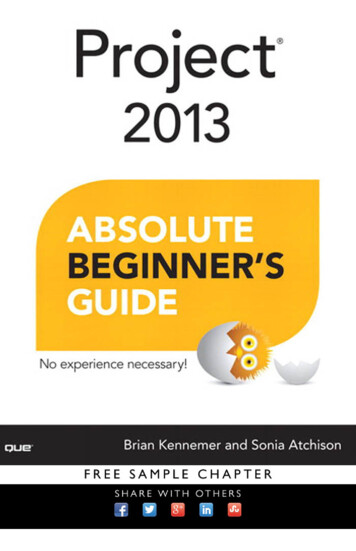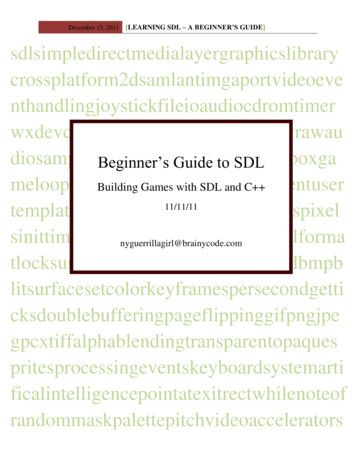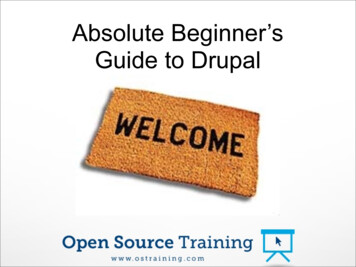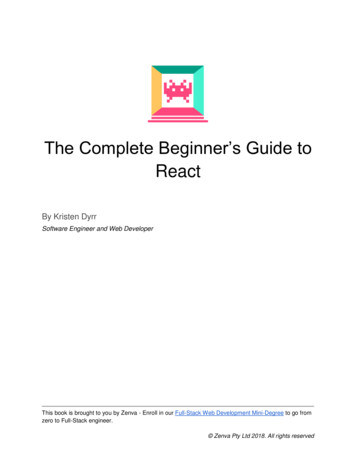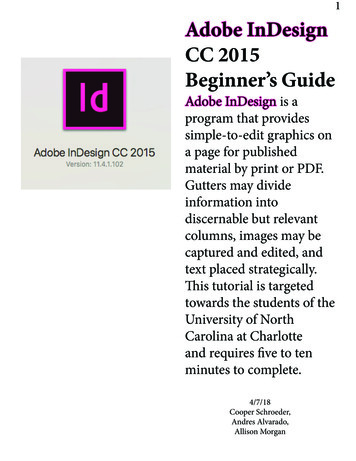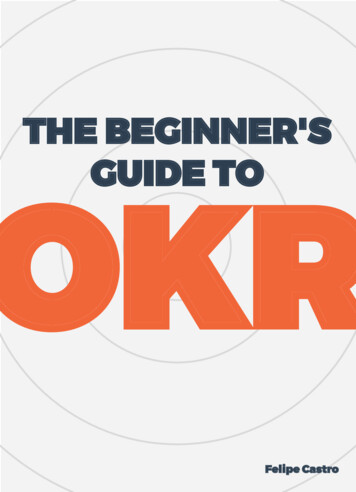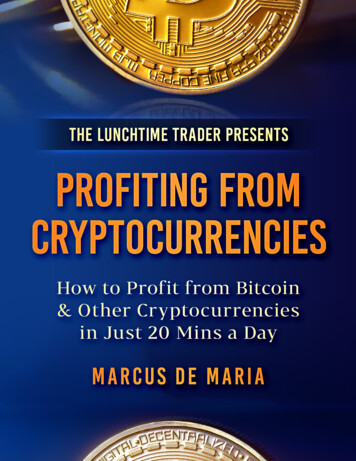
Transcription
Profiting FromcryptocurrenciesHow to profit from Bitcoinand cryptocurrencies in just20 mins a day(Includes section on How to Invest in Initial CoinOfferings – ICOs)Marcus de Maria1
Risk and Disclaimer:These Terms and Conditions form a part of InvestmentMastery Enrolment agreement with you (this ‘Agreement’)and apply to all online Membership coursesYourCryptoBook that are specified below and for whichyou wish to enrol (‘YourCryptoBook’ or ‘YCB’), to theexclusion of all other terms and conditions issued orstipulated by anyone else other than Investment Mastery.The information presented by Investment Mastery or anyof its staff is for educational purposes. Any examples usedare for educational and illustrative purposes only.Investment Mastery is not a stockbroker, broker dealer, orinvestment advisors. They are not recommendingparticular stocks, options, forex, CFD, Cryptocurrencies.The names of any firms of Crypto Exchange, stockbroker,stock exchange, financial institutions, financial planners,bookmakers, or financial websites mentioned are forillustrative purposes only. The decision on which companyto use if any is at the total discretion of each individualperson. It is recommended that you seek a professionallicensed broker prior to implementing any investmentprogramme or financial plan. The world ofCryptocurrenceis is HIGHLY speculative and you can loseall your investments. Investment Mastery cannotguarantee any results or investment returns based on theinformation you receive. You must read and understandthe above and be aware of the risks of all trading andinvesting and be willing to accept them before investing.2
3
Table Of Contents – Chapters and Headings1.Introduction2.What are the benefits and what problem does it solve?3.Why is it important for YOU?4.What are the main cryptocurrencies and what do they do?5.Where is the value of cryptocurrencies, how are prices determinedand what could Bitcoin be worth in the future?6.How to make money with cryptocurrencies?7.How to start buying Bitcoins, Ethereum and other Altcoins8.Which strategies do I use?9.How to keep your cryptocurrencies safe and store them10. How to track them once you have bought them11. How to make money i.e. when to sell them12. Is it too late to get into cryptocurrencies – have you missed theboat?13. What is an Initial Coin offering (ICO) and how to profit from it?14. Asset allocation and how much to invest in cryptocurrencies15. Are there any drawbacks to investing in cryptocurrencies?16. The future of cryptocurrency17. Cryptocurrency Frequently Asked Questions (FAQs)18. APPENDIXBitcoin White Paper – a Must Read for allHistory of Money4
5
ForewordI am not going to print this bookThe changes that are happening on an almost day to daybasis means that if I print it, parts of the book will beredundant within a few monthsCryptocurrencies and the Blockchain will change the waywe see the world.It cuts out middlemen, fees and timewasters.And at the same time, fortunes will be made.Not just by the owners of the companies, but by thoseindividuals who are brave enough to get involved at thisearly stage in investing in Cryptocurrencies, ICOs andcompanies set to benefit from blockchain technology.This book was written for you, the beginner, in mind.I hope it helps.The best is yet to come.To your successMarcus de Maria6
1. Introduction“Science-Fiction is now Science-fact”- UnknownAt the end of 2016 I read that some cryptocurrencies had gone up by 5000% injust 12 months. I decided to do some research, fast. This is what I found: 100worth of Bitcoins bought in 2010 would be worth well over 27 million today.How could I have missed out on those returns? It was time to get in.A few weeks of research later and I had bought 15 different cryptocurrenciesusing speculation money. Most of the coins quickly went into profit, somesubstantially. I decided I needed to take this more seriously and really do someresearch. If not me then who? If not now then when? You have to be in thegame to win it!I paid several thousand dollars for the best crypto subscription service I couldfind, and started buying more and more cryptos based on theirrecommendations. I got obsessed – I was even listening to it while goingrunning. At the time of writing, I now own more than 36 different cryptos andover 50 positions, have banked some profits and am still up over 70% on myentire investments. Not a bad start.7
As you can see, I invested 73,000 and made a profit of 64,000 which is an88% gain. This happened in as little as just 3 months. This was definitely helpedby a fast growing Altcoin called NEO. I invested just 850 and turned that into 26,300 profit! I am not sure where else you can do that at the current timebut it is possible with cryptocurrencies.So what are cryptocurrencies and where did it all start?1. A decentralised system for sending money to other peopleMost payment systems run on a centralised network. The problem with this isthat you have to incur unnecessary and expensive transaction fees. Usually,this is done by a central server that keeps track of your balances i.e. your creditcard and/or the banks. It can also take several days for one bank to talk toanother bank and so sending money becomes both expensive and takes toolong.A programmer calling himself Satoshi Nakamoto successfully found a way tobuild a decentralised digital cash system, thus avoiding the need for acentralised system. He describes it in a surprisingly simple way in his WhitePaper for Bitcoin, which I have added in the Appendix. You should read itbefore buying Bitcoin.8
A decentralised system means the network is powered by its users withouthaving any third party, central authority or middleman controlling it. Neithercentral banks or Governments has power over this system.2. What are cryptocurrencies?Cryptocurrencies are digital currencies which can be used to digitally transfermoney to another person safely, without having to use intermediaries ortrusted third parties, like a bank or Visa, e.g., to verify that you have sent themoney and the money is now no longer yours. You might want to read thatsentence again, slowly. In addition, it does it much faster at a fraction of thecost because it does away with unnecessary and expensive transaction fees.Why 'crypto'?The way digital currencies provide safety is two-fold. The first is that it usesEncryption technology (hence the name cryptocurrency).What is the blockchain?9
The second way is to have a public ledger, where all the transactions are kept.Thousands of computers around the world are linked together to display thisledger. They refresh and update every few minutes. This network of computersall linked together in this way is called the blockchain. You can trust it becauseit means that each transaction has been verified again and again by all thecomputers (the blockchain). With thousands of computers linked up all overthe world saying the same thing, the ledger’s integrity is upheld. Eachcryptocurrency can have its own blockchain, although some are shared.How does this work?Imagine I send you 10 dollars and you send the 10 dollars to someone else.Somehow someone has to keep track of these transactions, to avoid forgeriesor anyone claiming they haven’t received the money. In the past, Central Banksor banks have kept details of the transaction on something called a ledger. Thisis based on a centralised system. With Bitcoin, currently the main digitalcurrency, the whole system was turned on its head. Instead of a centralisedsystem controlling the ledger, now thousands of computers, all around theworld, each keep a copy of this Ledger. Every single transaction is kept there,from the beginning to present day. This is a decentralised system, called the‘blockchain’.Please note that money in itself does not have any intrinsic value – it is onlybecause we believe that it has value that it is worth anything. Money is just atracking system – we track what we own and what we owe. This is called aledger. Whatever form of money exists, we give it value because of its utility asa ledger (or tracking system of who owes what). That’s what the blockchain is –a giant decentralised ledger.Why are so many computers necessary?10
The idea comes from airplane safety. If you have one computer flying the planeand the system crashes, the airplane could crash. The thought was that if therewere three computers, and one crashed, then the fact that two computerswere saying something different to one meant that the two outweighed theone and the plane would continue even if one crashed. The inventors of theblockchain took it one step further and wanted as many computers as possibleto be in on it. So if there is a disagreement on a few computers of theblockchain, whatever the majority e.g. 51% are saying will win and thatinformation is put on the ledger on all the computers.A particularly brilliant analogy for this comes from Nick Szabo, the inventor ofBitgold, which many view as the precursor of Bitcoin. Imagine a fly trapped inamber. If there is only a small layer of amber, we know that the fly has notbeen trapped for very long. But if there is a big block of amber, we know thatthe fly has been trapped for a long time – no one can dispute that.The blockchain computers are forming a layer of amber every time atransaction occurs. Once the amber covers the transaction, it is very difficult tochange. Each layer of amber on top makes it more difficult to change. Each daymore information and more amber are layered on top.11
In other words, millions of small transactions, i.e. me sending you some moneyin another country, are documented on the blockchain, locking them in forgood, so that they can’t be changed afterwards. The information (or fly) istrapped as irrefutable evidence and the transaction can’t be undone. That'sthe whole point of the decentralised system – the computers allow it to remaindecentralised and in the hands of many as opposed to the hands of a few whoare trying to control the many.What are miners?There are two ways of getting Bitcoin. You can either buy one at the currentprice (today’s price is 4,200 for one Bitcoin) or you can ‘mine’ it. The analogyis like mining for Gold. However, with digital currencies it is slightly different,as you don’t have to go down a mine to do so. With cryptocurrencies, you haveto do it through something called, ‘Proof of Work’. Proof of Work refers to thefact that if you want a Bitcoin, you have to literally prove that you have donework and in return you get paid in Bitcoin tokens.In cryptocurrencies this is done by creating a scenario where if you want to getpaid in Bitcoins, you have to do something which is not easy to do i.e. you haveto commit your computers to solving puzzles or mathematical functions. If thecomputer solves the puzzle then it proves that you have dedicated power,time, effort, heat and computation to solve the problem. The more you do thisthe more of a ‘vote’ you are allowed to have. This vote is embodied in a Bitcointoken. You receive a token of Bitcoin (a fraction of a Bitcoin) in return formining it.Only miners are able to confirm a transaction. This is their role in thecryptocurrency network. They record transactions, verify them and dispersethe transactional information in the network.For every completed transaction monitored and facilitated by the miners, theyare rewarded with a token of cryptocurrency, for instance with Bitcoins.12
What this does is introduce scarcity into the system. Scarcity is importantbecause the only way anything has any value is because it is scarce. If Gold, likepebbles, were to be found everywhere, it wouldn’t have any value. ButBitcoins are not easy to mine – it takes computational power and time to do itAND there are a maximum of 21 million that can ever be mined. This createsinstant scarcity.TermsAn Altcoin (Alternative coins) is the name given to coins which were set up tocompete with Bitcoin, like Dash, Litecoin and even Dogecoin. The term‘crypto’, short for cryptocurrency, is used for all coins.A digital currency is a virtual currency. It is unregulated, issued and usuallycontrolled by its developers, and used and accepted among the members of aspecific virtual community. It is a medium of exchange that operates like acurrency in that specific environment but not necessarily outside of it.A cryptocurrency is a currency based on certain principles of cryptography. It isa type of digital token that relies on these principles to chain together digitalsignatures of token transfers. It is based on a peer-to-peer network and it isdecentralised.In most situations, cryptocurrency is also a digital currency, though, in evenmore cases, digital currency is not a cryptocurrency.Summary:Bitcoin is a software program that allows people to securely transfer moneyover the internet without a bank.It does this by replacing the function of a bank with a network of computersrunning the software that verifies and transfers the money.These computers, known as miners, maintain a global ledger of transactionsthat is used to validate, verify and transfer money.13
2. What are the benefits ofCryptos and whatproblem do they solve?The new digital revolution of money.Cryptocurrency has many appealing benefits. Some of this is thanks to theblockchain technology previously mentioned. It is a strictly monitored processwith encrypted transaction and control.A quick history of moneySince the beginning of human time, people have used something scarce as asource of value. At the start they used bartering one object for another. Buthow can you buy a cow if you only have two chickens? A third entity wasneeded, so they used the scarcest of seashells. Then came coins made ofprecious metals. At the beginning, coins did not have a value stamped onthem, rather the coins were weighed. Only later was an actual value stampedonto the coin.Next was paper money backed by precious m
Investment Mastery is not a stockbroker, broker dealer, or investment advisors. They are not recommending particular stocks, options, forex, FD, ryptocurrencies. The names of any firms of rypto Exchange, stockbroker, stock exchange, financial institutions, financial planners, bookmakers, or financial websites mentioned are for illustrative purposes only. The decision on which company to use if .


